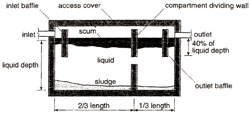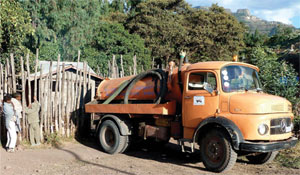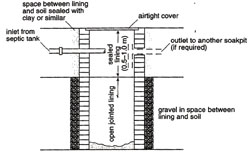19.3.1 Septic tanks
Septic tanks are used with water carriage sanitation systems. The human waste is washed into the tank, where it is stored and partially treated. A septic tank is a watertight chamber, usually made of concrete, and is mostly under the surface of the ground (Figure 19.3). They have inlet and outlet pipes. Fibreglass, PVC or plastic tanks can also be used. The retention time of the wastewater in septic tanks should be a minimum of 19 hours but can be a great deal longer.

The purpose of septic tanks is for the solids to settle out of the wastewater and for anaerobic decomposition of organic solids to take place. However, the treatment in a septic tank is only partial. The solids will be broken down in the tank and diluted in the wastewater but this will still contain high levels of organic pollutants. Septic tanks should only be used in places where water is plentiful and where vacuum trucks are available to remove sludge periodically from the chamber (Figure 19.4). The process of removing sludge from the septic tanks is called desludging.
 | Figure 19.4 A tanker pumping out sludge from a septic tank or latrine. (Photo: Nicholas Watson) |
Septic tanks are a storage and treatment unit to complement such facilities as WCs (cistern flush toilets), pour-flush toilets and aqua privies. The effluent from septic tanks is usually piped into a soak pit, also known as a seepage pit (Figure 19.5). A seepage pit is lined with open-jointed or porous material such as bricks or stone without mortar, which allows the wastewater to seep out slowly into the soil. Alternatively the wastewater may be spread across a drainage field using an array of pipes buried below the surface.
A septic tank has the following advantages:
- can be built and repaired with locally-available materials
- has a long service life
- presents no problem of flies and odour, if properly used
- has a relatively low capital cost (though it may not be affordable by rural households), and moderate operating costs
- does not require electrical energy because it uses gravity flow.
However, the constraints of a septic tank include the following:
- only applicable for water carriage sanitation systems
- treatment is only partial and the effluent may still contain pathogens
- sludge must be removed periodically.
19.3 Collection, storage and treatment of liquid waste

